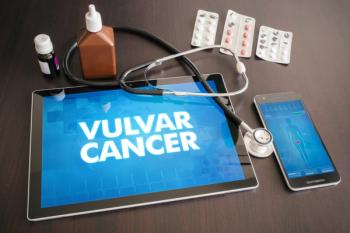
Pain in Endometriosis
OBGYN.net Conference CoverageFrom Endometriosis 2000 - 7th Biennial World Congress - London, May, 2000
Dr. Mark Perloe: "Hi, I’m Dr. Mark Perloe, I’m here in London at the World Endometriosis Society 2000 Meeting. We’re here with Dr. Ray Garry who is a Professor at the University of Teesside/South Cleveland Medical Center in Middlesborough, England. You’ve had an excellent presentation today on the pain and severity of endometriosis. Can you speak about the different types of pain associated with endometriosis?"
Professor Ray Garry: "Yes, clearly there are many different areas, the pelvis and the deep whole of the body which can cause pain. We tried to demonstrate in isolated lesions the sort of areas that can be involved. Of course, the most common areas are the uterosacral ligaments, the rectovaginal septum, and the ovary. Obviously very well known but less obviously and less clearly associated with endometriosis in the past, the bowel symptoms and ureteric and bladder symptoms, the diaphragm and even the abdominal wall can all being involved in all these specific types of areas."
Dr. Mark Perloe: "Where most physicians are aware that you need to work with obviously the typical lesions and with the advent of the disk and photos that you’ve put together, people are becoming more familiar with the atypical appearing lesions, but quite often that’s really not enough, according to your presentation, to really evaluate the patient who complains of pelvic pain."
Professor Ray Garry: "Yes, we believe that many of our patients have the true extensive lesions missed or at least under-diagnosed. If the physician is only concerned for looking for classic variable black spots, the typical lesion, they will miss many, many of the clinically most important lesions. A lot of lesions that occur are white, fibrotic, or even retroperitoneal and it’s important that during his examination with careful palpation behind the uterus of the uterosacral ligaments and vagina, rectovaginal septum, and particularly during laparoscopic evaluation that he test these areas. We have demonstrated a way of doing this by placing a probe in the rectum and in the posterior vaginal fornix and with these two probes it’s possible to delineate many of the lesions that are not obvious at that site."
Dr. Mark Perloe: "When nodules are diagnosed, what do you do?"
Professor Ray Garry: "I believe these are clearly patent for many of the symptoms. If you grasp on such a nodule, its painful tendencies in the vast majority of patients when they have symptoms, I believe you need to remove those - whether or not they are in surgically convenient spots like the uterosacral ligament where you can resect that easily or surgically very difficult spots such as on the rectum or on the ureter. I believe that there is clear evidence now with the benefit of attempting even quite heroic surgery, and I believe that’s justified by the severity of the symptoms and the impact these symptoms have on the patient’s over all quality of life."
Dr. Mark Perloe: "One of the technical aspects of when you’re doing this and you’re putting the probes into the vagina and the rectum, with the sense of palpation, are you doing it yourself or is your assistant doing this?"
Professor Ray Garry: "I always do this myself, there is very definitely a sense of feel with the instruments you’re using. Clearly, in laparoscopy, we have the superb visualization, but the one thing we miss is the sense of touch but you can replace most of that by becoming familiar with the movement of the instruments and even the sound the instruments make when they’re going across normal and abnormal tissue."
Dr. Mark Perloe: "So your position is doing a procedure for infertility laparoscopy and the patient that has no bowel symptoms or symptoms of pain but there is a plaque of endometriosis on the rectum. What do you advise in that situation?"
Professor Ray Garry: "My feeling is that we are to treat the symptoms, basically, this is severe surgery for severe symptoms. If the patient is asymptomatic and coping well with the endometriosis she has, in my opinion, I wouldn’t be keen to do major surgery in these circumstances. The only exception is if their infertility has been compromised by the presence of endometriosis. If she fails with IVF or whatever other treatment she’s having, it may help her to conceive to remove the endometriosis even if it’s not directly affecting the fallopian tubes, but in general terms if there’s no symptoms I wouldn’t perform this surgery."
Dr. Mark Perloe: You showed some wonderful pictures of involvement or cul-de-sac obliteration in a significant number of your patients. Do you find that most of those cases where there is stricture of the colon or extensive growth that that’s evident preoperatively with a sigmoidoscopy, is that a part of your pre-op evaluation?"
Professor Ray Garry: "The advanced sigmoidoscopy are a very disappointing investigation, we very seldom see, even when the patients are passing blood at the site of placement, that she actually has mucosal lesions that are seen on sigmoidoscopy. We find that very minimal if there’s more obliteration perhaps the most useful investigation is vaginal ultrasound and which we find a number of cases of this spectrum, but to be honest, the physical passage is our definitive test, you get a problem in the rectum where it develops distal nodes."
Dr. Mark Perloe: "You’re obviously not doing surgery, are you routinely doing any kind of pre-operative evaluation in the patient who has pain and you suspect bowel involvement?"
Professor Ray Garry: "In the patient who has definite bowel symptoms, we would routinely do at the very minimum the vaginal ultrasound and we may do an IVU of the bowel."
Dr. Mark Perloe: "Your study looked at the variety of patient complaints and then you have the outcomes at surgery. Did you find a correlation in the number of symptoms the patient presented and either the types of lesions, the location, the number of lesions?"
Professor Ray Garry: "There was only one case where this was truly evident and that was when the bowel was involved, the patient presenting symptoms typical with bowel movement, pain with bowel movement, the surgical removal of that correlated very well but on all other cases we found that there was very little correlation between presenting symptoms and findings and clinical resolution. We attributed this to the fact that very seldom did only one symptom and one site exist alone. Always there were multiple symptoms associated with multiple sites with endometriosis and this complex makes analysis very difficult and makes management very difficult but our basic feeling conclusive to this study was that unless we directed a target at each of the multiple sites and treated the patient as a whole with all the lesions, we surely wouldn’t help more."
Dr. Mark Perloe: "There were other presentations this morning by Dr. Vercellini on uterosacral nerve ablation and pre-sacral neurectomy, and the consensus of review of the data is that these are probably not effective procedures. Is that because the surgical removal isn’t too late or that procedure itself is not appropriate?"
Professor Ray Garry: "We think it’s probably because the procedure itself is not sufficient. We had a very interesting discussion yesterday with an anesthetist who is an expert in pain. He was saying that neurological pain frequently does not respond to division of the nerve and be exactly automatic (crowd noise) people who had their leg amputated for chronic pain and they still choose to have that phantom limb pain. This apparently is very common and well recognized so deriving on those is not necessarily going to lead the pain back. I think particularly, the uterosacral ligament was so commonly infiltrated with the disease that doing a so called maneuver, which is traditionally done very close to the uterus is almost the wrong side of the leg that will be consistent, distal to the incision and will still be sending the same messages to the spinal nerves. It was never my personal favorite operation anyway. I don’t regard it as efficient as tempting to remove the disease. I think the meta-analysis it does, however, that’s being shown really brought together today and really gave us a very clear guidance that this clinical hunch was probably best."
Dr. Mark Perloe: "Another comment that Dr. Bruce Lee made was that the use of a GnRH agonist is very effective while you’re using it and while you were suppressing menses but that a six month course of a GnRH agonist will only delay recurrence for a period of about six months. So many physicians have initiated addback therapy at the same that they began GnRH agonist and they keep patients on for a longer period of time. Do you believe that there is a role for addback therapy and GnRH over a longer course to get better pain control?"
Professor Ray Garry: "Yes, I personally believe that surgery is usually the primary treatment but for sure it is an incomplete treatment, nothing you do is 100% effective. We have patients who have a chronic condition which needs to be managed over a long period of time, and I believe that we need all the records possible. We have surgery, we have effective medication, and I certainly believe that as Paolo was saying it really is not so much the drug which lasts for six months and then it’s finished for the patient who’s got a problem for many, many years. We need therapies that will enable to tide her over for maybe periods of years so we have an image of doing the maximum surgery and getting the maximum remission. When that remission is finished try to supplement or adjuvant therapy with GnRH analogues with certainly all other medications and mix and match until we get the best combined therapy based. These are difficult cases."
Dr. Mark Perloe: "Now I understand that endometriosis is far more complicated and not a disease that every gynecologist is well trained to deal with. A person wants to go and learn more and experience a multimedia presentation about this, how might they be able to obtain that information without having to come here to London?"
Professor Ray Garry: "Thank you very much. We have produced a series of CD-ROM’s on aspects of endometriosis, more specifically directed at physicians and gynecologists with an interest in this area, trying to show diagnosis of all grades of the disease and suggested surgical or medical management. The other CD-ROM is patient oriented, and it tries to explain to the patient what the disease is and what treatments she might undergo. We would be very happy to make available this CD to anyone who wishes to take advantage of it."
Dr. Mark Perloe: "Do you have a website that people can go to learn more about the disks?"
Professor Ray Garry: "We do indeed,
Dr. Mark Perloe: "Obviously it will be on the web page, when people come to look at this, we’ll put up a link. Thank you so much."
Newsletter
Get the latest clinical updates, case studies, and expert commentary in obstetric and gynecologic care. Sign up now to stay informed.











